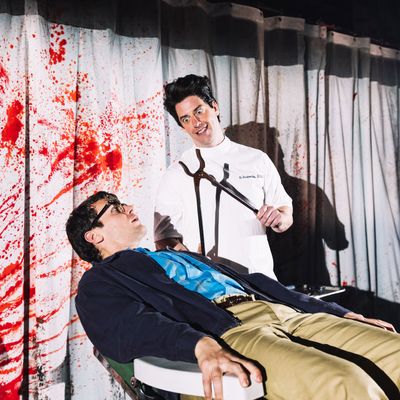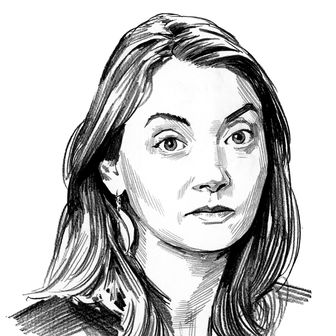
The highest compliment I can pay to Little Shop of Horrors, now bopping away at the Westside Theater, is that it feels like a high-school production. You might not think that’s praise, considering its A-team cast members — all pitching hard with nobody saving his arm — and the uniformly high production values. Under Michael Mayer’s direction, this Little Shop is glossy and plump, its Julian Crouch set tucked comfortably into its little Off Broadway stage. Yet the show’s most charming quality is its feeling of having been put on for the hell of it. I’m sure it’s going to make money. It’s a dream cast of consummate pros. But — and my eyes look like hearts while I type this — the infectious energy is pure amateur.
The story is familiar, since it’s essentially Faust. The hapless Seymour Krelborn (Jonathan Groff) works for Mr. Mushnik (Tom Alan Robbins) in his terrible flower shop down on skid row. His flower-shop colleague and dream girl Audrey (Tammy Blanchard) is out of reach: She dates the abusive dentist Orin Scrivello (Christian Borle), sure that’s all she deserves. One day, Seymour begins to tend a strange and unusual plant, a Venus flytrap-type monstrosity that he calls the Audrey II. The exotic brings attention; attention brings fame; fame brings money and love. But the plant only eats human flesh. “Feed me, Seymour!” as the old saying goes. And so Seymour lets himself be coaxed into a deal with the devil.
In 1980, Alan Menken and Howard Ashman decided to adapt Little Shop from Roger Corman’s bananas 1960 B movie The Little Shop of Horrors, which Ashman had loved since he saw it on TV as a 14-year-old in Baltimore. “Later,” he said, “I met tons of people who saw it when they were 14 or 15. I never met anyone who saw it as an adult.” He and Menken, coming off an unsuccessful production, needed a pick-me-up, so they decided to indulge themselves with something purely fun. What could be cozier than a favorite cult movie, goofy as a dog in pants?
Corman had shot in two days. Menken and Ashman, after they’d decided on ’60s kitsch pastiche, wrote the musical in two months. And when you watch Little Shop you can feel both the teenage enthusiasm and those initial flying rushes toward creation. The show is nearly indestructible: Even junior-high productions can’t ruin it. Alan Menken’s imitation Motown harmonies and yearning suspensions sit as easily on an unprepared voice as one that’s won a Tony. So when you do lavish the show with marquee talents, it feels like superabundance.
Christian Borle (who does indeed have Tonys, for Something Rotten! and Peter and the Starcatcher) is sort of the show mascot. He’s a Chaos Generator through and through, popping up in tiny roles (a passerby, an NBC executive), and exploiting every opportunity for a laugh. Give him an inch, he’ll steal the scene. But when he’s given the scene, like the one with his song “Dentist” — performed with the Greek chorus–like Urchins (sometimes known as the Skid Row Supremes) — he devours it. His overscale Elvis-pompadour bobbling, he leaps up and down the stoops, or flops into the laps of Crystal (Salome Smith), Chiffon (Joy Woods), and Ronnette (Ari Groover). He tickles his nipple to draw our attention to the embroidery on his dentist’s smock. And all due respect to the Audrey II puppets, each successive version of which is a plushy miracle (designed by Nicholas Mahon and operated by Eric Wright, Teddy Yudain, Kris Roberts and Chelsea Turbin), but the real Muppet onstage is Borle. He makes himself narrow and goggle-eyed like Beaker; he unhinges his jaw like Cookie Monster; he bounds onstage like Miss Piggy at a ball.
Groff has to anchor the show, playing straight man to his crooked plant, so for the most part he does a tidily milquetoast performance, deliberately letting other voices and players dominate him. Suddenly, though, he’ll open the sluice. At one point, provoked by Audrey II — the big growling plant (Kingsley Leggs) is really getting hungry — Seymour sings, “I have so, so many strong reservations!” and he swings through the Mushnik & Son flower shop’s door. He steps out into an entirely new voice: twice as loud, twice as strong. You get a sense of what kind of power he’s leashing.
While Groff is intermittently keeping his light under a bushel, Tammy Blanchard is knocking her bushel over. The musical’s original Audrey, Ellen Greene (who also played her in the 1986 movie and in a City Center revival in 2017) was a bottle rocket: tiny, powerful, darling. In contrast, Blanchard is big and broken, slurring her words like she’s on Seconal, always stumbling slightly in her heels. Blanchard won an Emmy for playing Judy Garland, and here she fuses the Fay Wray–stylings of Greene’s Audrey to her own, sloppier, late-stage-Judy idea. Her mouth slides over the lyrics for her pleading ballad “Somewhere That’s Green,” which cracks and loses pitch as her heart breaks. Every other thing in this production is a joke. I’m almost positive that Borle is actively trying to get other actors to laugh. So what is this crushing portrait of twilight need and despair doing here? It’s a brilliant performance, but it has a slight stubbornness about it. Whatever else is happening in her cartoon universe, Blanchard won’t treat Audrey’s subtext blithely — her black eyes really give her pain.
There’s another not-very-hidden subtext in this show. On the one hand, Little Shop seems like icing on a cupcake — nothing could be sweeter. You leave humming. You sing around the house for days. But the show is also disturbing, and not only because of Audrey’s bruises. Too often Little Shop–lovers gloss over its racial critique, the deliberate association of alien invasion tropes with anti-black panic.
The central characters dream of white flight to the suburbs (“gotta get outta here”). Audrey II’s voice has traditionally been a black man’s — when casting the Four Tops’ Levi Stubbs for the movie, Frank Oz said he wanted someone who “was real black, real street,” who “had a touch of malevolence but could be real silly and funny at the same time.” Apart from the sheer yikes value of that statement, it’s clear that the juxtaposition of that “street” voice with Seymour’s quavering tone is at the heart of much of the show’s humor and threat. Musically, too, the show links race to disruption. Menken and Ashman built the show out of spoofed mid-century musical styles: close-harmony Motown, Broadway cheese, doo-wop, tango, New Orleans funk. The black outsiders — Audrey II and the choral trio — tend to get the funk and the Motown; the central group sounds whiter. The choices are specific and pointed. Menken knew what he was about.
So should a production grapple with those issues? Mayer’s version doesn’t; it’s on a nostalgia trip, interested in good vibes only. And certainly I adored this Little Shop, and I’d recommend it to anyone who can get in. It offers a contact high from the sheer glee of the company, the way they seem to have done it for love, rather than whatever their Equity contracts have gotten them. It’s so pure! But even if you push down your queasy thoughts about race during the effervescent proceedings, they might come bubbling out during the curtain call. With the whole cast lined up in front of you, it’s harder to deny the weird way Little Shop has distributed its opportunities. Out come the Urchins, the three best voices in the show, blendable powerhouses that are basically the show’s brass section — and you don’t know their characters’ names. And then came Kingsley Leggs, a.k.a. Audrey II. He was in his street clothes (no need for a costume), and he materialized rather shyly for his bow. But surely he’s the star! We needed a little more time to applaud him.
Little Shop of Horrors is at the Westside Theater through January 19.


